Junyeop Lee
3d human motion generation from the text via gesture action classification and the autoregressive model
Nov 18, 2022



Abstract:In this paper, a deep learning-based model for 3D human motion generation from the text is proposed via gesture action classification and an autoregressive model. The model focuses on generating special gestures that express human thinking, such as waving and nodding. To achieve the goal, the proposed method predicts expression from the sentences using a text classification model based on a pretrained language model and generates gestures using the gate recurrent unit-based autoregressive model. Especially, we proposed the loss for the embedding space for restoring raw motions and generating intermediate motions well. Moreover, the novel data augmentation method and stop token are proposed to generate variable length motions. To evaluate the text classification model and 3D human motion generation model, a gesture action classification dataset and action-based gesture dataset are collected. With several experiments, the proposed method successfully generates perceptually natural and realistic 3D human motion from the text. Moreover, we verified the effectiveness of the proposed method using a public-available action recognition dataset to evaluate cross-dataset generalization performance.
RewriteNet: Realistic Scene Text Image Generation via Editing Text in Real-world Image
Jul 23, 2021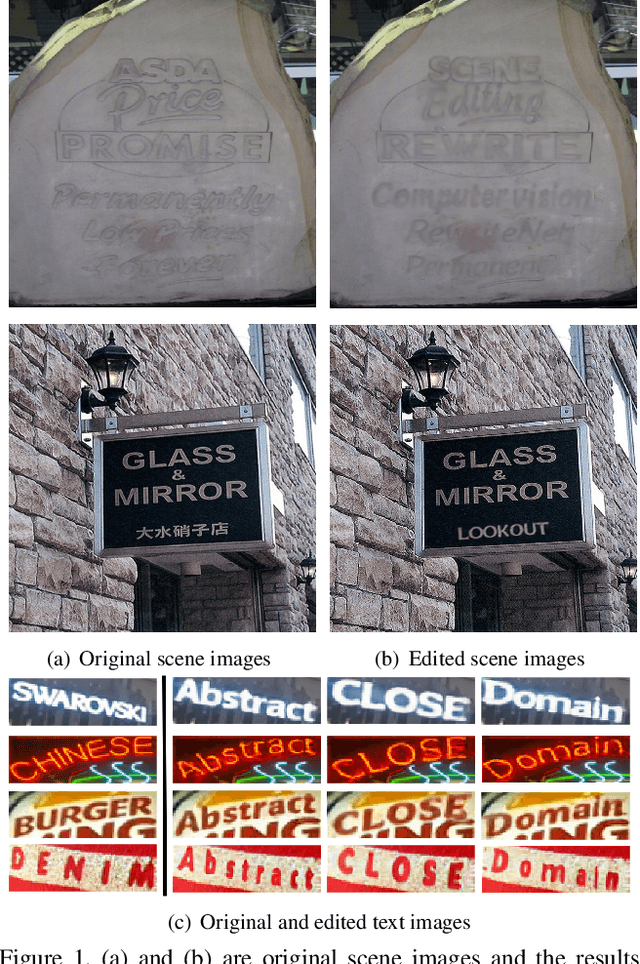
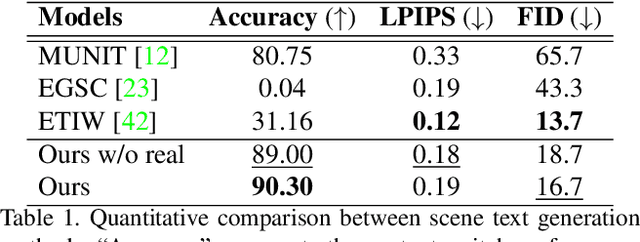
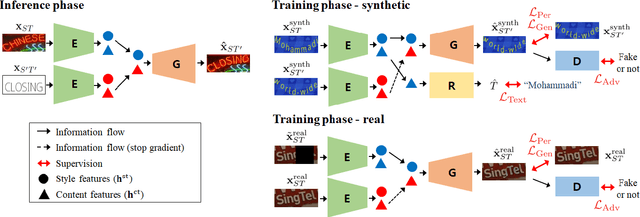
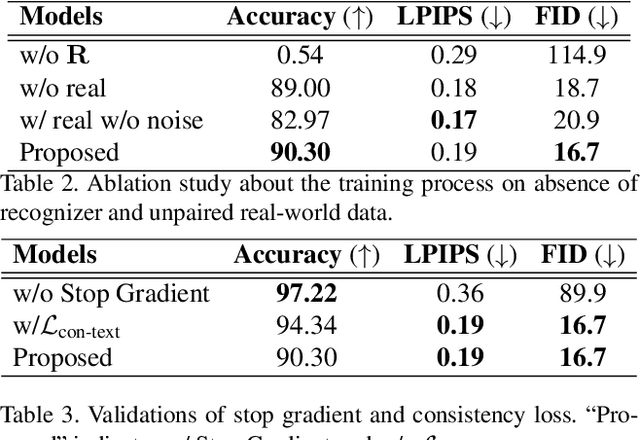
Abstract:Scene text editing (STE), which converts a text in a scene image into the desired text while preserving an original style, is a challenging task due to a complex intervention between text and style. To address this challenge, we propose a novel representational learning-based STE model, referred to as RewriteNet that employs textual information as well as visual information. We assume that the scene text image can be decomposed into content and style features where the former represents the text information and style represents scene text characteristics such as font, alignment, and background. Under this assumption, we propose a method to separately encode content and style features of the input image by introducing the scene text recognizer that is trained by text information. Then, a text-edited image is generated by combining the style feature from the original image and the content feature from the target text. Unlike previous works that are only able to use synthetic images in the training phase, we also exploit real-world images by proposing a self-supervised training scheme, which bridges the domain gap between synthetic and real data. Our experiments demonstrate that RewriteNet achieves better quantitative and qualitative performance than other comparisons. Moreover, we validate that the use of text information and the self-supervised training scheme improves text switching performance. The implementation and dataset will be publicly available.
Character Region Attention For Text Spotting
Jul 19, 2020

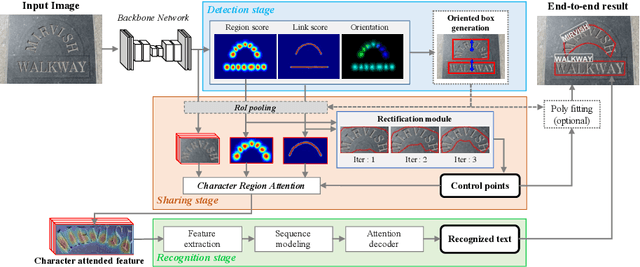
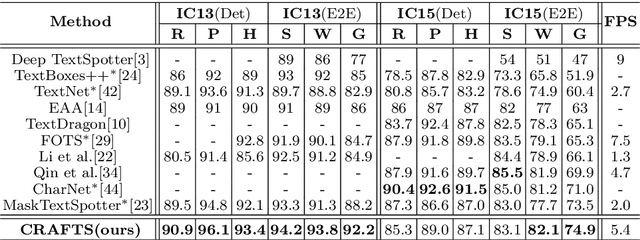
Abstract:A scene text spotter is composed of text detection and recognition modules. Many studies have been conducted to unify these modules into an end-to-end trainable model to achieve better performance. A typical architecture places detection and recognition modules into separate branches, and a RoI pooling is commonly used to let the branches share a visual feature. However, there still exists a chance of establishing a more complimentary connection between the modules when adopting recognizer that uses attention-based decoder and detector that represents spatial information of the character regions. This is possible since the two modules share a common sub-task which is to find the location of the character regions. Based on the insight, we construct a tightly coupled single pipeline model. This architecture is formed by utilizing detection outputs in the recognizer and propagating the recognition loss through the detection stage. The use of character score map helps the recognizer attend better to the character center points, and the recognition loss propagation to the detector module enhances the localization of the character regions. Also, a strengthened sharing stage allows feature rectification and boundary localization of arbitrary-shaped text regions. Extensive experiments demonstrate state-of-the-art performance in publicly available straight and curved benchmark dataset.
CLEval: Character-Level Evaluation for Text Detection and Recognition Tasks
Jun 11, 2020



Abstract:Despite the recent success of text detection and recognition methods, existing evaluation metrics fail to provide a fair and reliable comparison among those methods. In addition, there exists no end-to-end evaluation metric that takes characteristics of OCR tasks into account. Previous end-to-end metric contains cascaded errors from the binary scoring process applied in both detection and recognition tasks. Ignoring partially correct results raises a gap between quantitative and qualitative analysis, and prevents fine-grained assessment. Based on the fact that character is a key element of text, we hereby propose a Character-Level Evaluation metric (CLEval). In CLEval, the \textit{instance matching} process handles split and merge detection cases, and the \textit{scoring process} conducts character-level evaluation. By aggregating character-level scores, the CLEval metric provides a fine-grained evaluation of end-to-end results composed of the detection and recognition as well as individual evaluations for each module from the end-performance perspective. We believe that our metrics can play a key role in developing and analyzing state-of-the-art text detection and recognition methods. The evaluation code is publicly available at https://github.com/clovaai/CLEval.
NTIRE 2020 Challenge on Perceptual Extreme Super-Resolution: Methods and Results
May 03, 2020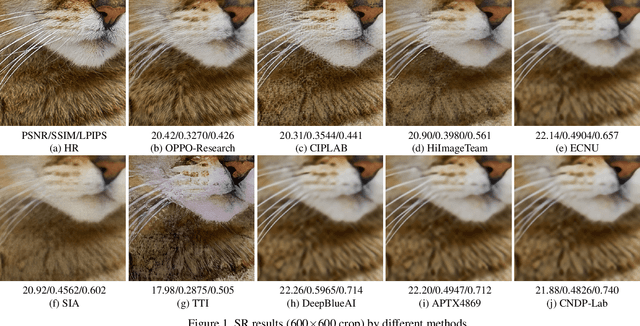
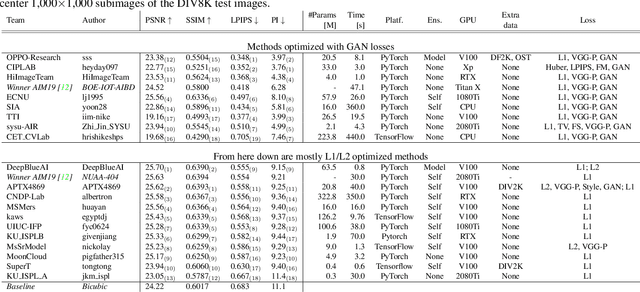
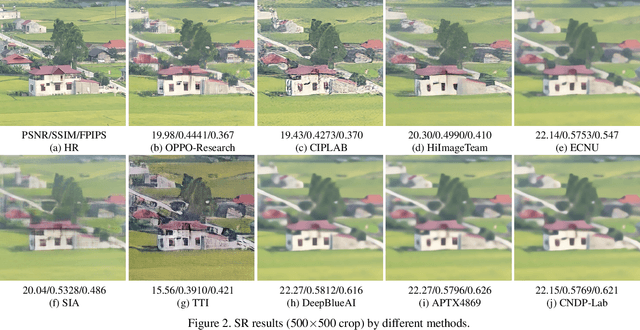
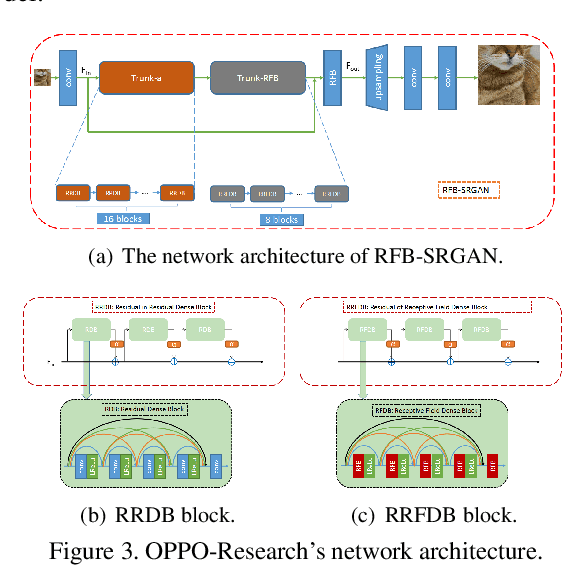
Abstract:This paper reviews the NTIRE 2020 challenge on perceptual extreme super-resolution with focus on proposed solutions and results. The challenge task was to super-resolve an input image with a magnification factor 16 based on a set of prior examples of low and corresponding high resolution images. The goal is to obtain a network design capable to produce high resolution results with the best perceptual quality and similar to the ground truth. The track had 280 registered participants, and 19 teams submitted the final results. They gauge the state-of-the-art in single image super-resolution.
On Recognizing Texts of Arbitrary Shapes with 2D Self-Attention
Oct 10, 2019



Abstract:Scene text recognition (STR) is the task of recognizing character sequences in natural scenes. While there have been great advances in STR methods, current methods still fail to recognize texts in arbitrary shapes, such as heavily curved or rotated texts, which are abundant in daily life (e.g. restaurant signs, product labels, company logos, etc). This paper introduces a novel architecture to recognizing texts of arbitrary shapes, named Self-Attention Text Recognition Network (SATRN), which is inspired by the Transformer. SATRN utilizes the self-attention mechanism to describe two-dimensional (2D) spatial dependencies of characters in a scene text image. Exploiting the full-graph propagation of self-attention, SATRN can recognize texts with arbitrary arrangements and large inter-character spacing. As a result, SATRN outperforms existing STR models by a large margin of 5.7 pp on average in "irregular text" benchmarks. We provide empirical analyses that illustrate the inner mechanisms and the extent to which the model is applicable (e.g. rotated and multi-line text). We will open-source the code.
What is wrong with scene text recognition model comparisons? dataset and model analysis
Apr 03, 2019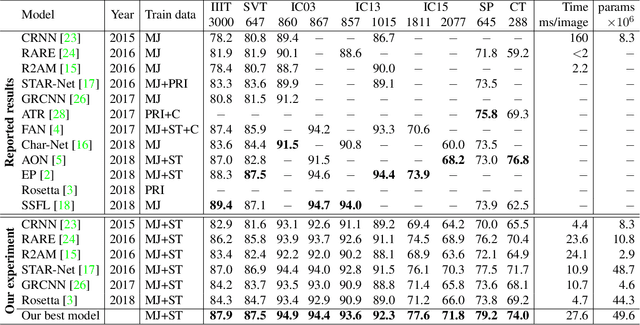
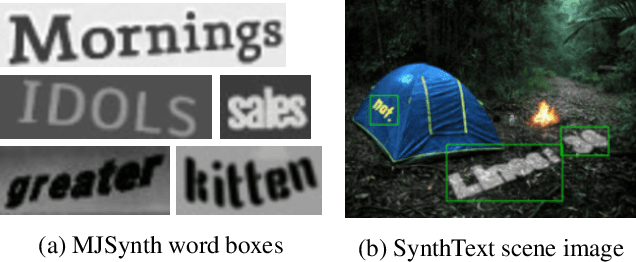

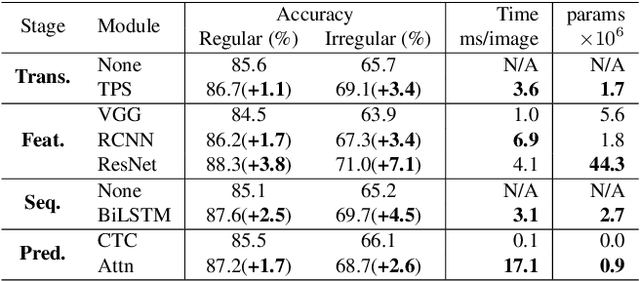
Abstract:Many new proposals for scene text recognition (STR) models have been introduced in recent years. While each claim to have pushed the boundary of the technology, a holistic and fair comparison has been largely missing in the field due to the inconsistent choices of training and evaluation datasets. This paper addresses this difficulty with three major contributions. First, we examine the inconsistencies of training and evaluation datasets, and the performance gap results from inconsistencies. Second, we introduce a unified four-stage STR framework that most existing STR models fit into. Using this framework allows for the extensive evaluation of previously proposed STR modules and the discovery of previously unexplored module combinations. Third, we analyze the module-wise contributions to performance in terms of accuracy, speed, and memory demand, under one consistent set of training and evaluation datasets. Such analyses clean up the hindrance on the current comparisons to understand the performance gain of the existing modules.
 Add to Chrome
Add to Chrome Add to Firefox
Add to Firefox Add to Edge
Add to Edge